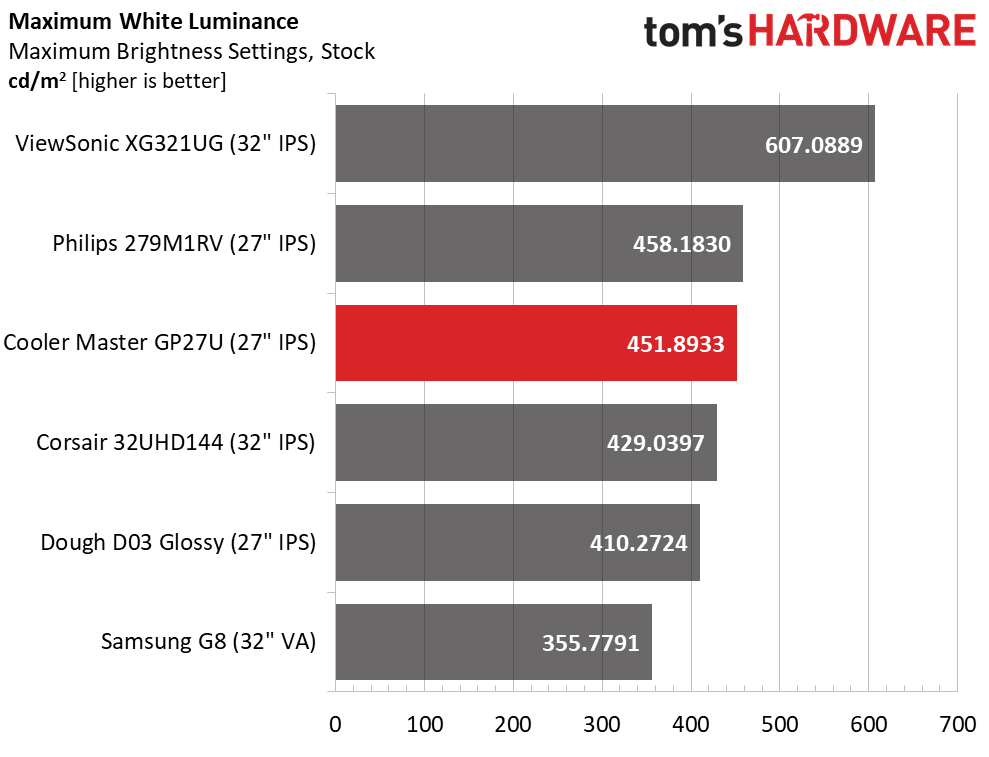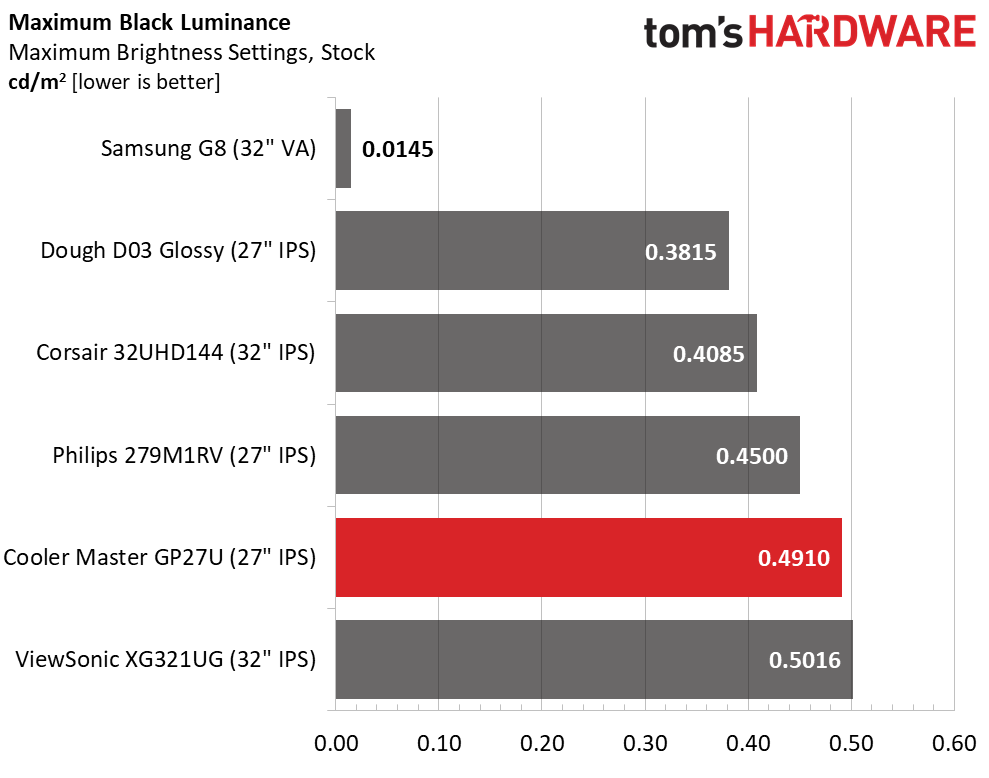Why you can trust Tom's Hardware
To read about our monitor tests in-depth, please check out Display Testing Explained: How We Test PC Monitors. We cover brightness and contrast testing on page two.
Uncalibrated – Maximum Backlight Level



In the GP27U’s User 1 mode, I measured a peak white level of 451.8933 nits, more than enough for any work or play environment. The backlight can be adjusted over 100 steps, but 200 nits was setting 24, which means the minimum is a bit high at 64 nits. That’s a reasonable level for darkroom use. My only actual complaint is that below 200 nits, each click of the slider drops brightness by 3-5 nits. That’s a bit coarse for my taste. I would prefer to see finer control.
Black levels are IPS average, so the contrast is also average at 920.3:1. Local Dimming is available for SDR signals, increasing dynamic range significantly. Even on the Low setting, I couldn’t measure black, so contrast can be theoretically infinite.
After Calibration to 200 nits



Calibration improves contrast slightly to 991.1:1, moving the GP27U up to fourth place. Again, this is average IPS performance. The Samsung is well ahead of the pack because its local dimming is always engaged and cannot be disabled.
The GP27U maintains its contrast ratio in the ANSI test, which speaks to its engineering and construction. The grid polarizer is precisely fitted, maintaining high intra-image contrast and a sharp image.
MORE: Best Gaming Monitors
MORE: How We Test PC Monitors
Get Tom's Hardware's best news and in-depth reviews, straight to your inbox.
MORE: How to Buy a PC Monitor: A 2022 Guide
MORE: How to Choose the Best HDR Monitor
Current page: Brightness and Contrast
Prev Page Response, Input Lag, Viewing Angles and Uniformity Next Page Grayscale, Gamma and Color
Christian Eberle is a Contributing Editor for Tom's Hardware US. He's a veteran reviewer of A/V equipment, specializing in monitors. Christian began his obsession with tech when he built his first PC in 1991, a 286 running DOS 3.0 at a blazing 12MHz. In 2006, he undertook training from the Imaging Science Foundation in video calibration and testing and thus started a passion for precise imaging that persists to this day. He is also a professional musician with a degree from the New England Conservatory as a classical bassoonist which he used to good effect as a performer with the West Point Army Band from 1987 to 2013. He enjoys watching movies and listening to high-end audio in his custom-built home theater and can be seen riding trails near his home on a race-ready ICE VTX recumbent trike. Christian enjoys the endless summer in Florida where he lives with his wife and Chihuahua and plays with orchestras around the state.
-
healthy Pro-teen Reply
it depends on the resolution you want, for example, the Alienware QD-OLED monitor is 175HZ and not a lot more expensive but it's 1440P instead of 4K. the tempest is the fine value at a thousand dollars.helper800 said:Not OLED and >1000 dollars, no thank you. -
helper800 Reply
You can get a 4k OLED for less than a thousand dollars...healthy Pro-teen said:it depends on the resolution you want, for example, the Alienware QD-OLED monitor is 175HZ and not a lot more expensive but it's 1440P instead of 4K. the tempest is the fine value at a thousand dollars.
Newegg has since changed the link to a different product. The Aorus FO48U monitor. -
PlaneInTheSky ReplyAlienware QD-OLED monitor is 175HZ and not a lot more expensive but it's 1440P instead of 4K
Samsung's QD-OLED (which that Alienware uses) has a lot of artefacts and color fringing issues.
Just search "color fringing qd-oled" and you'll get hundreds of people pointing out the issues with QD-OLED.
OLED has this problem in general, but it is worse on the QD-OLED from samsung.
-
helper800 Reply
When you are viewing content and playing games there are no issues. This issue with QD-OLED is also partially a windows problem because they do not support the pixel layout of the monitor. You can get a 3rd party program that fixes this issue for non-windows ui and text elements within it. You can completely fix this issue for W-OLED with ClearType.PlaneInTheSky said:Samsung's QD-OLED (which that Alienware uses) has a lot of artefacts and color fringing issues.
Just search "color fringing qd-oled" and you'll get hundreds of people pointing out the issues with QD-OLED.
OLED has this problem in general, but it is worse on the QD-OLED from samsung.
-
PlaneInTheSky ReplyWhen you are viewing content and playing games there are no issues.
In every game with text, the color fringing of QD-OLED and OLED, IS a major issue.
Monitor makers are trying to damage control this issue, but when people are paying so much money for an OLED monitor and they realize OLED tech has color fringing issues that even $100 VA or IPS panels don't have, that leaves a very sour taste in people's mouth.
The color fringing is also an issue with high contrast UI elements.
-
helper800 Reply
I am literally staring at this on my W-OLED tv 44 inches from my eyes and cannot distinguish any fringing. My brother's QD-OLED has some fringing at appropriate viewing distances but, like I said, there are 3rd party text clarity programs that can fix the issue in some circumstances.PlaneInTheSky said:In every game with text, the color fringing of QD-OLED and OLED, IS a major issue.
Monitor makers are trying to damage control this issue, but when people are paying so much money for an OLED monitor and they realize OLED tech has color fringing issues that even $100 VA or IPS panels don't have, that leaves a very sour taste in people's mouth.
The color fringing is also an issue with high contrast UI elements.
52eiLP3Zy-sView: https://www.youtube.com/watch?app=desktop&v=52eiLP3Zy-s -
Lug "The only caveat is that you must turn off Adaptive-Sync to go above 144 Hz "Reply
Not with firmware update from December 2022.. :
Changelog:
Adaptive Sync (VRR) and Local Dimming can now be enabled together.Fixed some instances where the KVM would not automatically switch to a new signal input.
More overall flexible color adjustments in all picture modes.
Enabling Adaptive Sync will no longer limit the refresh rate to 144Hz, and instead works up to 160Hz (both HDMI 2.1 and DP). -
healthy Pro-teen Reply
That AORUS FO48U could be a legit alternative, but The tempest has Brighter, better HDR, and a higher refresh rate. I'll consider it If it ever comes back into stock.helper800 said:You can get a 4k OLED for less than a thousand dollars...